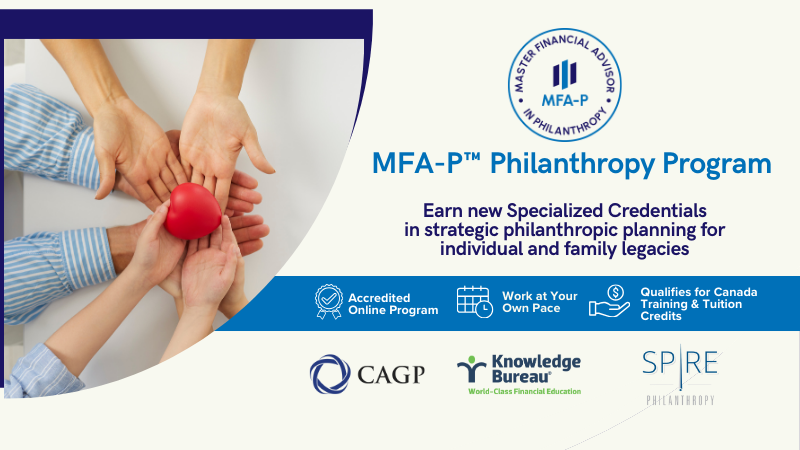More Taxfilers, Fewer Charitable Donors

Knowledge Bureau Staff
According to Statistics Canada, although we have seen an increase in taxfilers by about 6%, we have seen a decline in the number of donors by approximately 7%. However, the good news is that the value of the donations, in dollars, has increased by almost 15% over a five year period.
Now is the time to make a commitment to give to charity. Typically, tax deductible gifts are cash; however, don’t forget you may also give gifts in kind and receive a donation receipt. It’s the gift that keeps giving back. Working with an MFA-P™, a professional trained in strategic philanthropy can help.
Here are some tax tips to consider:
To donate in kind is relatively simple. If you can determine the gift’s fair market value you can receive a charitable donation receipt for it. Here are some rules to observe:
Qualifying gifts. It is possible to donate personal property, such as a cottage, listed personal property, such as art, jewelry or a coin collection and depreciable property such as a car. You can also donate insurance policies and various financial instruments such as securities and real property, such as land, buildings and a rental property.
Qualifying donees. Gifts must be made to qualifying donees. These include registered charities, registered Canadian amateur athletic associations, registered municipalities, certain  universities outside of Canada, low cost housing corporations set up for the aged, Her Majesty in the right of Canada and registered journalism organizations.
universities outside of Canada, low cost housing corporations set up for the aged, Her Majesty in the right of Canada and registered journalism organizations.
Tax consequences. There may be tax consequences before you give property, based on the FMV at the time of gift. For example, there may be a capital gain on personal property, real property or intangible property.
There are special rules for the transfer of qualifying shares to your favorite charity, however. In that case, capital gains are avoided.
Those who are artists, dealers or collectors or others carrying on a business may have a full income inclusion for the value of the gift, first, to be offset by the donation receipt.
Donations are also limited to 75% of net income; except on the final return, when the limit is 100% of net income. Special rules exist for gifts made in a will. In that case they may be deemed to have been made by the deceased’s Graduated Rate Estate. The 100% limit also applies to gifts of ecologically sensitive land.
Unclaimed portions of donations can be carried forward for 5 years; 10 years in the case of ecologically sensitive land.
Valuation. CRA points to several rules on the matter. First, if the fair market value (FMV) of the gift is less than $1000, a competent person with “sufficient knowledge can determine the value of it. This can include the charity. However, if the gift is worth more than $1000, CRA recommends a professional appraisal by a third party – someone, they say, not associated with the donor. The appraiser’s contact information is required on the official donation receipt in that case.
There are special rules if the property is donated within 10 years of acquisition or through a tax shelter arrangement. In these cases, the lesser of FMV or the cost may be used.
Bottom Line: Advisors in all fields need to take the initiative to have the conversation with our clients about charitable giving, especially this year. We need to have our researched recommendations ready to help facilitate the logistics of gifting securities in-kind to allow more tax-efficient gifts. By being tax-efficient, the client can give more to their desired charity with the same out-of-pocket expense.
https://www150.statcan.gc.ca/t1/tbl1/en/cv.action?pid=1110013001